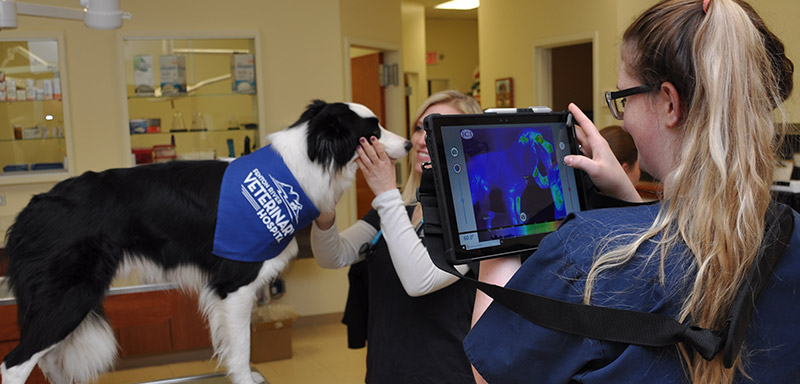Thermal imaging is a technique that uses heat-sensitive cameras to create images of objects, people or even entire scenes based on their temperatures. These images show the different levels of thermal radiation that different objects emit, which can then be used by law enforcement officers, health care professionals and other groups when they are out in the field. People who work with thermal imaging systems need to have an understanding of how they work, so they can use them most effectively.
There are two main types of thermal imaging systems: passive and active. Passive systems detect infrared radiation from an object and convert it into an image for display on a screen or other output device. Active systems actually emit infrared light at an object to measure its temperature. Both types of systems can create very useful images, but they have different strengths and weaknesses.
Thermal imaging has a wide range of potential uses in veterinary medicine. It can be used to detect health problems in animals, locate injured or sick animals in the field, and even help with search and rescue efforts. Thermal imaging can also be used to monitor the environment around animals, such as detecting changes in temperature that could indicate a fire or other hazard.
One of the most common uses for thermal imaging in veterinary medicine is for early detection of illness in animals. Many diseases cause changes in an animal’s body temperature, which can be detected with thermal imaging. This allows veterinarians to diagnose and treat illnesses much sooner than would be possible without thermal imaging.
The benefits of using thermal imaging in veterinary medicine
There are many benefits to using thermal imaging in veterinary medicine. One of the biggest is that it can help identify health problems much earlier, leading to faster diagnosis and treatment for animals. This can not only save time and money, but also improve the overall health outcomes for these animals.
Thermal imaging can also be used to locate injured or sick animals in difficult-to-access areas, helping to reduce stress on both the animal and its rescuers. And by monitoring the environment around animals, it can help protect them from fires, extreme temperatures, and other threats. Overall, thermal imaging offers a powerful tool for improving veterinary care and helping keep animals healthy and safe.
How thermal imaging can be used to diagnose and treat medical conditions in animals
Thermal imaging is a powerful tool that can be used in veterinary medicine to diagnose and treat a wide range of medical conditions in animals. One of its key advantages is that it allows veterinarians to detect changes in temperature that indicate the presence of certain diseases. This makes it possible to identify illnesses much earlier, leading to faster diagnosis and treatment for animals.
In addition to diagnostic uses, thermal imaging can also be applied therapeutically in cases where monitoring an animal’s temperature can help improve recovery outcomes. For example, by using thermal imaging cameras to monitor body temperature during surgery or other intensive treatments, veterinarians can ensure that these procedures are done safely and effectively. Overall, thermal imaging offers many benefits for improving both the diagnosis and treatment of medical conditions in animals.
How thermal imaging can be used to locate injured or sick animals
Thermal imaging can also be used to locate injured or sick animals in difficult-to-access areas. By detecting changes in temperature, these systems can help rescuers quickly find and retrieve animals that are lost or trapped. This can not only save time and money, but also reduce the stress on both the animal and its rescuers.
Thermal imaging can also be used to monitor the environment around animals, such as detecting changes in temperature that could indicate a fire or other hazard. This information can then be used to help protect these animals from potential dangers. Overall, thermal imaging offers a powerful tool for improving animal welfare and safety.
Some of the latest advances in thermal imaging technology for veterinary use
Thermal imaging technology is constantly evolving, and there have been many recent advances in the development of thermal cameras for veterinary use. One of these is the miniaturization of these devices, which has led to the creation of handheld thermal cameras that are much easier to use in a clinical setting.
Another major advance is the development of wireless thermal cameras, which can be used remotely to monitor animals from a distance. This can be especially useful for monitoring large animals, such as horses or cattle, without having to enter their enclosure.
Overall, these advances in thermal imaging technology are making it an increasingly valuable tool for veterinarians and helping to improve the care and treatment of animals.
The future of thermal imaging in veterinary medicine
Looking ahead, it seems likely that thermal imaging will continue to play an increasingly important role in veterinary care. As new advances continue to be made in thermal cameras and other related technologies, it is likely that we will see these tools being used more frequently in a range of different applications.
In addition, as more people become aware of the benefits of using thermal imaging in veterinary medicine, we are likely to see growing demand for these technologies among animal owners and veterinarians alike. Ultimately, this may lead to broader adoption of thermal imaging across the field of veterinary medicine, helping to improve both diagnosis and treatment outcomes for animals around the world.
